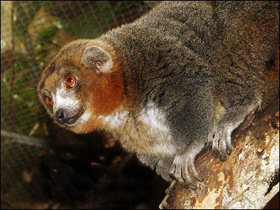The mongoose lemur (Eulemur mongoz)
 The mongoose lemur (Eulemur mongoz) is included in the IUCN Red List as "endangered"
The mongoose lemur (Eulemur mongoz) is included in the IUCN Red List as "endangered"
Habitat
The mongoose lemur (Eulemur mongoz) is a species of strepsirrhine primate in the family Lemuridae.
The Eulemur mongoz is found in the dry deciduous forests of Madagascar, as well as in the humid forests of the Comoros. This makes it one of only two lemur species living outside Madagascar, although it is believed to have been transported to the Comoros by humans.
Appearance and behaviour
The Eulemur mongoz is the smallest member of the genus, smaller than the average cat. Its body length varies from 31 to 45 cm, its long tail reaches 45-65 cm.
The male has a white nose, blackish rings around the eyes, red cheeks and a black and grey forehead with a greyish stripe. The occiput, neck and part of the back are dark grey in contrast to the brownish-grey colouration of the rest of the back and limbs. The lower part of the body is light brown with a greyish stripe on the chest. Feet and hands light, sometimes almost white.
The colouring of the female is generally the same, except that her cheeks are pure white, her abdomen and legs are also white on the inside, and she has a black stripe on her forehead.
The animals lead a strictly arboreal and diurnal life, roaming in groups of three or four individuals at most. They are very agile, run fast, always with their tails raised, and perform daring leaps, dropping with a characteristic growl on all four legs.
The young of both sexes are born with a white beard on the muzzle, but at six weeks of age, sexual dimorphism is already evident in their appearance, as the males turn red on the muzzle.
Life style
Eulemur mongoz are active both day and night, depending on the season: during the wet season they are mainly active during the day and during the dry season at night.
Eulemur mongoz live in trees and are good jumpers, using their leaps to move from one tree to another.
They form small family groups, usually consisting of an adult male and female and their young.
Each group defends its territory quite aggressively against other groups. The young are usually born before the rainy season, between August and October.
Pregnancy lasts 4 months and the female feeds the young with milk until they are five months old. These primates reach sexual maturity at the age of three years and the young lemurs leave their group soon after.
The longevity of this species in captivity is up to 26 years, in the wild they live up to 20 years.
Nutrition
Eulemur mongoz feed on fruits, flowers, leaves and tree sap. Occasionally they eat larvae and beetles.
Status
Captive mongoose lemurs can live up to 26 years, while wild specimens live 18–20 years. Mongoose lemurs in the wild are threatened by the destruction and fragmentation of the forests in which they live, and also by hunting. Their numbers have dwindled by about 80% over a period of 25 years, and the International Union for Conservation of Nature has rated their conservation status as "critically endangered". Mongoose lemurs are more endangered in Madagascar, but there could be a way to conserve them in Comoros because of the increase of these species' population in the area. People should continue to work together and protect these critically endangered species.
















































